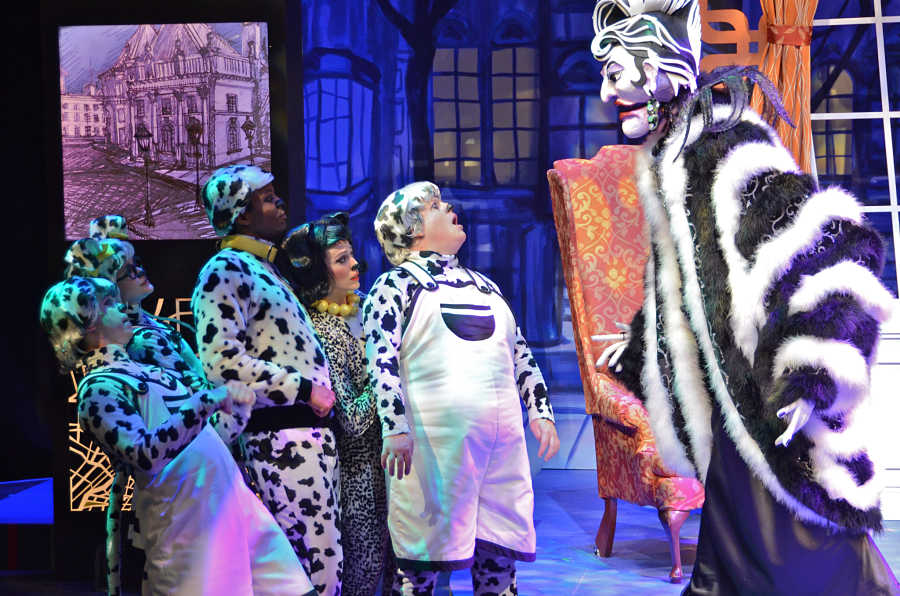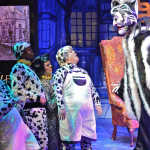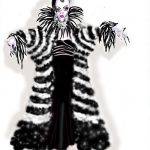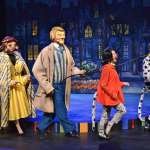The challenge: Mount 101 Dalmatians, the musical, using just nine actors. For this coproduction between Children’s Theatre of Charlotte and Imagination Stage (where it’s currently running through Jan. 11), bunraku puppetry and over-the-top hair anchored the story of Dalmatian dogs Pongo and Missus, as they set out to save their puppies from the villainess (and fur lover) Cruella de Vil. Scroll below to find out more about the design process, and to view a slideshow from the production.

Janet Stanford, DIRECTION: The dogs in 101 Dalmatians actually narrate the story, and they call the humans their pets. So, in a way, we wanted the human beings to be simplified and made almost alien, so as to be not nearly as human or appealing as the dogs. I really wanted the human characters to be eight-foot puppets, so the actors playing the dogs could stand up and be anthropomorphized without being the same height as the humans.
Puppet designer Matthew Pauli came up with the concept of how this would work. He decided most of the human beings would have two working arms, so that the actors’ own hands could serve as the hands of the puppets. The only puppet that opened its mouth was Cruella, because she is a loudmouth who sings a couple of very big, frightening numbers.
So the actress [Sarah Beth Pfiefer] had one arm that she could move with her right hand while her left hand is inside the puppet operating the mouth—the other arm is kind of like a dummy arm. Many people play puppets as well as dogs, so you could cover up your dog costume inside your puppet. For example, Cruella doubles as the Nanny, and you only see the actress’s face briefly when she plays Clover the Cow. So the actors are back there madly jumping in and out of puppets. The subtitle of the show is “101 Costume Changes”!
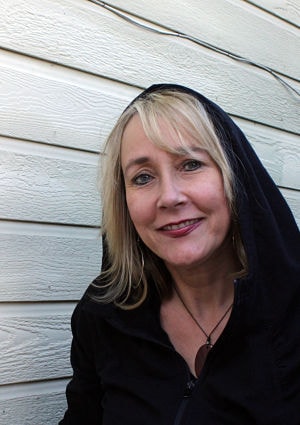
Connie Furr Soloman, COSTUME DESIGN: Janet sent me a cartoon showing two dogs walking humans, and she said, “This is our show.” So that image informed the show from that moment onward. It’s the puppies’ story.
The puppetry was loosely based on bunraku; each actor was wearing a backpack that had the neck and shoulders and the head of the puppet towering above their own. I knew the heads needed to be larger to be in proportion—but I also thought that 100-percent realism wasn’t what was called for. So I carved and worked with clay to create the look. In Cruella’s research, I found these amazing high-fashion hairstyles—one had a two-tone black-and-white twist high up in the air, which ended up being Cruella’s hairstyle. She was a very angular, kind of high-fashion villain. For each human character, I was trying to find real humans who kind of fit the bill, whose features I could take and exaggerate them.
In developing the Dalmatians, we very much did not want to put them on all fours. I worked with a fabulous wig master in Charlotte to create the ears so that they had a bit of a sculptural quality—then hair was laid down on top to follow the wave of the ear flapping. With their spotted wigs, spotted bodies and little black-and-white suits, it was a good solution for the Dalmatians. The story is set in the 1950s, so that inspired a good bit of the hairstyles.
101 Dalmatians—based on the children’s book by Dodie Smith—had a book by Martha King De Silva and music and lyrics by Joan Cushing. The production, under the direction of Janet Stanford, ran Sept. 19–Oct. 19 at Children’s Theatre of Charlotte, N.C., then Nov. 19–Jan. 11 at Imagination Stage in Bethesda, Md. The show featured puppet design by Matthew Pauli , scenic design by Milagros Ponce de Leon, costume design by Connie Furr Soloman, lighting design by David Fillmore, sound design by Jason Romney and properties design by Peter Smeal.

